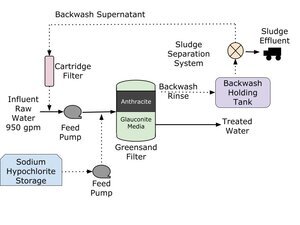
College of Engineering Unit:
Crestop Well in the Lakedale Utility District has trace amounts of iron, manganese, and hydrogen sulfide that restrict use of the well. This project proposes treatment operations, preliminary designs, and pilot scale testing of a treatment system that will remove iron and manganese below the Secondary Maximum Contaminant Levels (SMCLs), as well as reduce the quantity of hydrogen sulfide in the finished water. The proposed design aims to minimize energy, cost, and maintenance required for operation. After comparing several treatment methods, a greensand filtration system was proposed as the optimal alternative for the Crestop Well project because it provides the most efficient treatment process, has lower capital costs, and satisfies the goals of Lakedale Utility District. Greensand is a filtration media coated with manganese dioxide, a catalyst for the oxidation of iron, manganese, and hydrogen sulfide. Influent water from the Crestop Well will be dosed with sodium hypochlorite then delivered through a greensand filter capped with anthracite. Oxidation and filtration will occur simultaneously within the greensand filter and the resulting water will be sent to distribution. Greensand filters yield very high removal rates of the target constituents.
Sustainability of the treatment system was considered, including safety, public welfare, and environmental impacts. Sodium hypochlorite will be generated on site to avoid safety hazards for operators. Lakedale Utility District administrators will benefit from obtaining a treatment system for the Crestop Well because it will enable the district to provide water from a local source. Treatment for the Crestop Well will also allow customers and clients of the district to continue using safe drinking water without the risk of water shortages. Environmental impacts of the water treatment plant were minimized by designing a system with a small footprint to reduce impacts on wildlife habitat, stormwater runoff from impervious surfaces, and limited noise and odor pollution.
| Attachment | Size |
|---|---|
| 380.77 KB |